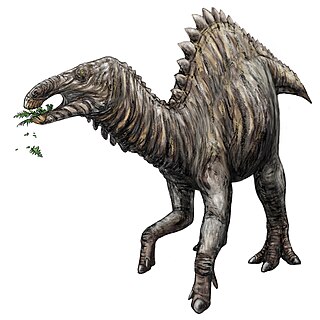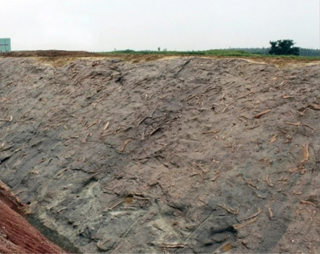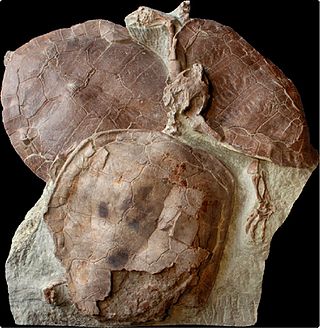Chingkankousaurus is a genus of theropod dinosaur containing the single species Chingkankousaurus fragilis. C. fragilis is known only from a single fossilized bone fragment from the late Cretaceous Period Wangshi Series of Shandong province in eastern China.

Tanius is a genus of hadrosauroid dinosaur. It lived in the Late Cretaceous of China. The type species, named and described in 1929 by Carl Wiman, is Tanius sinensis. The generic name honours the Chinese paleontologist Tan Xichou. The specific epithet refers to China. In 2010 Gregory S. Paul estimated the length of Tanius at 7 metres (23 ft) and its weight at 2 metric tons.
Sinemys is an extinct genus of turtle from the Late Jurassic to Early Cretaceous of China and Japan. Three species have been named: S. lens, the type species, from the Kimmeridgian-Tithonian of Shandong; S. gamera, from the Valanginian-Albian of Nei Mongol; and S. wuerhoensis, from the Aptian-Albian of Xinjiang. The species S. gamera is noted for the presence of a pair of elongate spines projecting outwards and backwards from seventh costal of the carapace. These may have served a hydrodynamic function.

The Wangshi Group is a geological Group in Shandong, China whose strata date back to the Coniacian to Campanian stages of the Late Cretaceous. Dinosaur remains are among the fossils that have been recovered from the group.
Kirgizemys is an extinct genus of turtle from Early Cretaceous of China, South Korea, Mongolia, Russia and Kyrgyzstan.
Anomalochelys is an extinct genus of land turtle from the Upper Cretaceous of Hokkaido, Japan, Guangdong, China.
Shantungosuchus is an extinct genus of Early Cretaceous crocodyliform found in China. It includes three species: Shantungosuchus chuhsienensis and S. brachycephalus, which were both described by Yang Zhongjian – usually referred to as "Young" – in 1961 and 1982, and S. hangjinensis, which was described by Xiao-Chun Wu et al in 1994. S. chuhsienensis is the type for this genus.
Jiangxichelys is an extinct genus of nanhsiungchelyid turtle which existed in Ganzhou, Jiangxi Province, China during the latest Cretaceous epoch. It was first named by Haiyan Tong and Jinyou Mo in 2010 and the type species is Jiangxichelys ganzhouensis. It was an aquatic omnivore, as modern turtles are today.

Trionyx is a genus of softshell turtles belonging to the family Trionychidae. In the past many species in the family were classified in this genus, but today T. triunguis, the African or Nile softshell turtle, is the only extant softshell still classified as Trionyx. The other species still assigned to this genus are only known from fossils. T. triunguis is a relatively large, aquatic piscivore.
Protoxinjiangchelys is an extinct genus of xinjiangchelyid turtle known from the Early to Late Jurassic of China. It is known from the single species P. salis, which was named and described in 2012. It contains only the holotype, ZDM 3009, which consists of a complete shell with an articulated carapace and a complete plastron and possibly another, older specimen.

Paleontology or palaeontology is the study of prehistoric life forms on Earth through the examination of plant and animal fossils. This includes the study of body fossils, tracks (ichnites), burrows, cast-off parts, fossilised feces (coprolites), palynomorphs and chemical residues. Because humans have encountered fossils for millennia, paleontology has a long history both before and after becoming formalized as a science. This article records significant discoveries and events related to paleontology that occurred or were published in the year 2013.

Egg fossils are the fossilized remains of eggs laid by ancient animals. As evidence of the physiological processes of an animal, egg fossils are considered a type of trace fossil. Under rare circumstances a fossil egg may preserve the remains of the once-developing embryo inside, in which case it also contains body fossils. A wide variety of different animal groups laid eggs that are now preserved in the fossil record beginning in the Paleozoic. Examples include invertebrates like ammonoids as well as vertebrates like fishes, possible amphibians, and reptiles. The latter group includes the many dinosaur eggs that have been recovered from Mesozoic strata. Since the organism responsible for laying any given egg fossil is frequently unknown, scientists classify eggs using a parallel system of taxonomy separate from but modeled after the Linnaean system. This "parataxonomy" is called veterovata.

Khunnuchelys was a genus of trionychine turtle from the Late Cretaceous of Asia. Three species are known, K. erinhotensis, the type species, K. kizylkumensis, and K. lophorhothon. K. erinhotensis is known from the Iren Dabasu Formation in China from the late Turonian until the middle Campanian. K. kizylkumensis is known from the late Turonian Bissekty Formation of Uzbekistan. The third species, described in 2013 by Danilov et al., is known from the early to middle Campanian aged Bostobe Formation of Kazakhstan.

Macrobaenidae is an extinct family of turtles, known from the Early Cretaceous to Paleogene of Laurasia. Their relationships to other turtles and whether they form a monophlyletic group are controversial. They are typically interpreted as stem or crown group cryptodires, but some more recent analyses have found them to lie outside crown group Testudines. Macrobaenids can be distinguished from other testudinatans by the presence of a carotid fenestra, cruciform plastron with strap-like epiplastra, and a lack of extragulars.

Sinemydidae is an extinct family of turtles from Cretaceous to Paleocene deposits in Asia and North America. Their exact position is engimatic, they have alternatively been considered stem-group cryptodires, but also "crownward stem-turtles" alongside Macrobaenidae, Paracryptodira, Xinjiangchelyidae, Thalassochelydia and Sandownidae outside of crown Testudines.

Xinjiangchelyidae is an extinct family of turtles known from the Lower Jurassic to the Middle Cretaceous of Asia and western Europe. They have generally been interpreted as either being basal cryptodires or placed outside of crown Testudines.

Laiyangosaurus is a genus of saurolophine hadrosaurid from the Late Cretaceous Jingangkou Formation of China. It is known from one species, L.youngi, found in the Laiyang Basin within the province of Shandong.

Anomalipes zhaoi is an extinct caenagnathid dinosaur discovered in China. It lived during the Campanian-aged Wangshi Group in China. It is the only species in the genus Anomalipes.

Meiolaniformes is an extinct clade of stem-group turtles, defined as all taxa more closely related to Meiolania than to Cryptodira and Pleurodira. It is known from the Early Cretaceous to the Holocene of Australia, Oceania and South America. Some Eurasian taxa have been suggested to be part of the group, but this is disputed.
Sinankylosaurus is a genus of dinosaur, originally described as an ankylosaur, from the Late Cretaceous Hongtuya Formation of Shandong, China. The genus contains a single species, Sinankylosaurus zhuchengensis, known from a nearly complete right ilium. The describers claim that the discovery of Sinankylosaurus further demonstrates the similarity between dinosaurs of eastern Asia and western North America.











